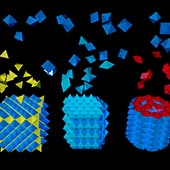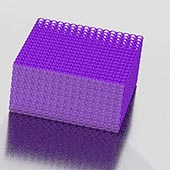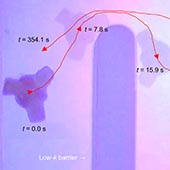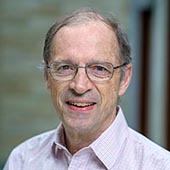CBES News
Read the most recent Center for Bio-Inspired Energy Science (CBES) news below, and
subscribe to our newsletters to stay informed about what is happening at CBES. Stories from previous years are available in our
News Archive.
DNA becomes ‘blueprint’ and ‘hands’ to construct advanced materials
January 23, 2024
In CBES-supported research published in Science, investigators led by Chad Mirkin and Sharon Glotzer introduced a novel strategy to assemble polyhedral nanoparticles.
In the new approach, nanoparticles encoded with DNA are designed to recognize particles with complementary shapes and arrange them to form space-filling structures. So far, this strategy has led to the synthesis of 10 new colloidal crystals that would not be possible to prepare otherwise and that have the potential to be used for the design and construction of metamaterials with unprecedented properties.
Making material advancements at the nanoscale
October 5, 2023
In an interdisciplinary collaboration supported by CBES, researchers led by Horacio Espinosa and Chad Mirkin explored how nanoscale materials can be organized into macroscopic structures that exhibit properties that exceed those of conventional bulk materials and those exhibited by natural systems. They implemented a novel approach to design and assemble nanoscale materials using colloidal crystal engineering with DNA, which provides precise control over the arrangement of nanoparticles and enables the creation of complex lattice structures.
Encoding autonomy in a photo- and electroactive hydrogel
September 7, 2023
Nature Reviews Materials published a research highlight of CBES-supported work on autonomously functioning photo- and electroactive hydrogels for soft robotic applications. The hydrogels developed in CBES director Samuel Stupp’s laboratory can capture and deliver cargo, avoid obstacles, and return to their original positions — all without external, stepwise control.
This research was originally published in Science Advances.
Schatz wins Award for Extraordinary Impact in Physical Chemistry
February 20, 2023
CBES investigator George Schatz has received the 2023 Marsha I. Lester Award for Extraordinary Impact in Physical Chemistry, an honor given by the Physical Chemistry Division of the American Chemical Society. Schatz was recognized “for broad-ranging contributions to leadership in physical chemistry, and to advances in reaction dynamics, plasmonics, self-assembly of soft materials, and other fields.”




